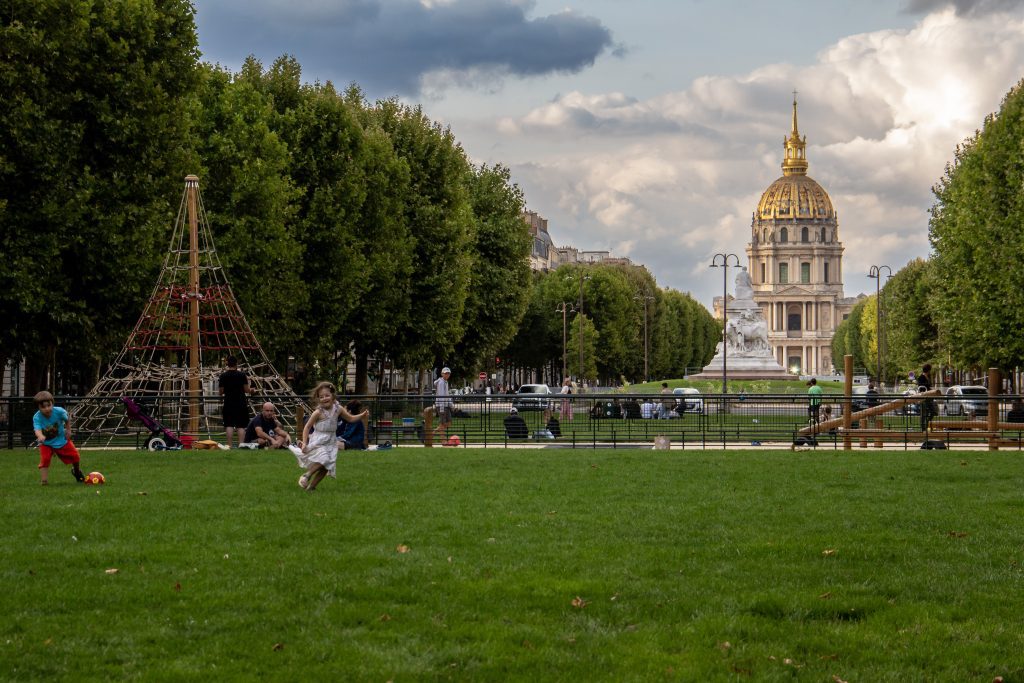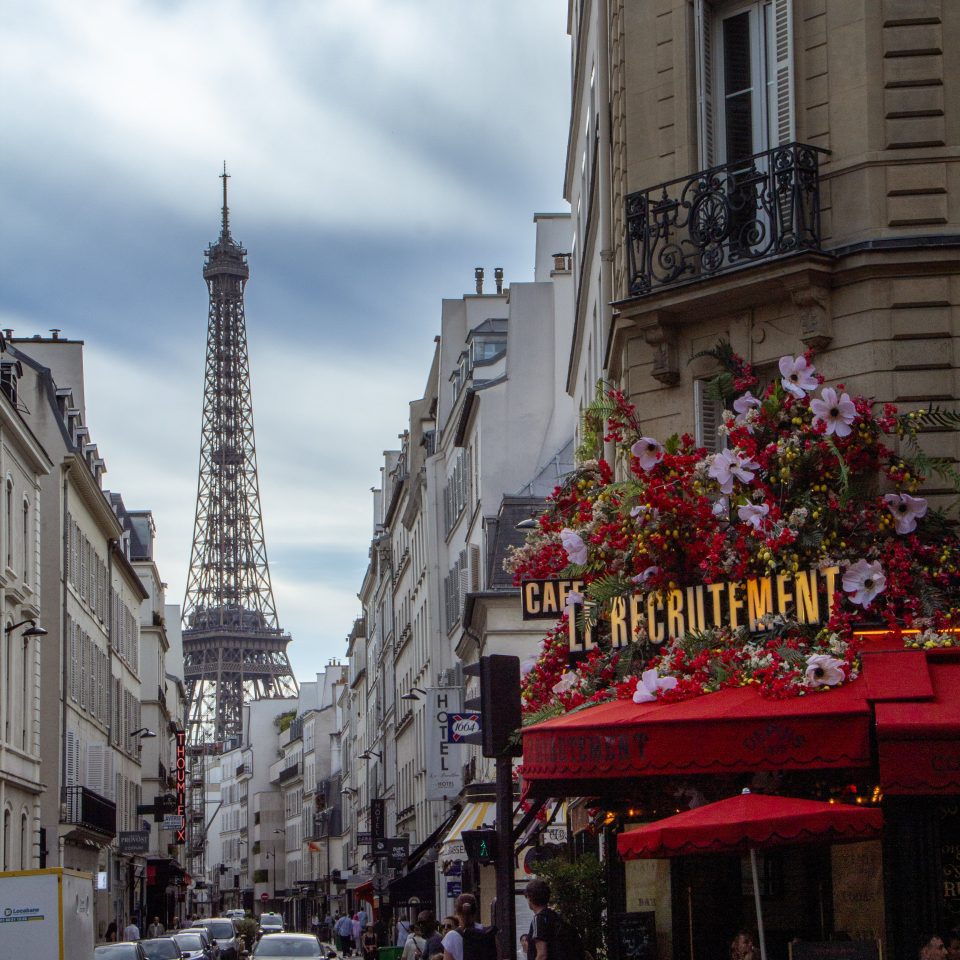Scene One: Outside of Hôtel des Invalides

On a quiet evening on August 2nd, children play outside Hôtel des Invalides as their parents sit watching, their backs turned to the strikingly beautiful and historically iconic building.
The sun was setting as we were headed to find dinner, a small breeze danced through the air, and dark, looming clouds threatened rain. Children could be heard playing as cars drove past behind me. There were not many tourists here, only what appeared to be locals, enjoying their weekend evening.
Before capturing this image, I stood, marveling at the striking Cathedral, unaware of my surroundings other than the trees leading me to the gold-covered dome. It was only upon aligning my eye with the viewfinder in my camera that I noticed the children. Though once I did, I felt my setting suddenly appear. I heard their screams and laughter as they chased their soccer ball. I heard the hollow bounce as the boy kicked the red and yellow ball. I heard feet crunching across the gravel path. I felt a small breeze sneak through the trees and across my skin. Suddenly, my environment felt so much busier than I had first believed. When planning to take the picture, I was confident that Hôtel des Invalides would be my subject. How could it not? However, as I lowered the camera from my eyes and took in a brand new environment, the subject became muddled. I began to wonder, how many times had these children taken their soccer ball to this park? How many times had they passed this park on their way to school? How many times had their parents hurried them along the sidewalk I stood on? Though there was an intricately beautiful golden dome behind them, filled with France’s most important military history, I could not help but draw my attention to the children.
Suddenly, they were what made my photo so interesting.
Scene Two: The Mona Lisa

People crowd around the Mona Lisa on Sunday, August 8th, just past one in the afternoon.
As strangers approach the painting, they raise their cameras into the air, looking through their screens before laying eyes on the painting. Staff are stationed at the front, ushering people out to make room for more guests. The room is dark blue and covered with paintings on all sides. Galleries fill the left and right walls with painters who go unnoticed. More paintings lie behind the wall the Mona Lisa is on, and Monal Lisa herself stares at the very largest painting in the room, located on the wall behind the crowd. The room is loud, and shoes squeak noisily against the wooden floors. Being inside the crowd feels claustrophobic. Elbows push from left and right in an attempt to get a step closer to the 77 × 53 cm painting. Within the crowd, it becomes incredibly difficult to take in the painting and appreciate the artist. Instead, one finds themselves erecting their phone into the air just as everyone else does to get a photo similar to the ones seen countlessly in any Google search of the Mona Lisa.
The first time I entered Salle des États, the room the Mona Lisa is in, I was shuffled into the center crowd, inching closer and closer to the Mona Lisa. When my time came, I too posed, just as everyone before me, with the Mona Lisa in the background. Not 30 seconds later, I was whisked out of the area where the Mona Lisa was hung. I decided to take a second lap around the room, this time, hugging the perimeter. Once again, similar to the first photo I shared, my ability to fully soak in my environment was delayed. The first time around, I only briefly looked at the massive painting, the Wedding Feast at Cana by Paolo Veronese, directly opposite the Mona Lisa. I missed the galleries surrounding her. I missed the interactions between people. I was so focused on getting through the crowd, glancing at the Mona Lisa, taking my picture, and exiting.
I find that such an experience is not limited to beautiful historical buildings or famous paintings. Indeed, in my own life, I can move so quickly that I forget to look around me. I forget to notice interactions between strangers. I forget to notice the environment I sit, stand, walk, or run in.
Although there may be one incredible painting by a talented artist that deserves our attention, the setting in which the painting is found deserves our attention, too.
Scene Three: A Cliffside in Giverny, France

Cows graze in a field in Giverny, France, about 82 kilometers outside of Paris.
The Sun shines brightly in the middle of the day, and a breeze helps keep the temperature at a comfortable warmth. The Seine is located just off the photo in the distance. The photo is taken at the top of a cliff, too far from the cows to hear them ‘Moo’. The environment I stand in feels disconnected from the environment I took a photo of.
Like looking at a painting, I feel like an outsider staring at a muse. However, unlike the Mona Lisa at the Louvre, this painting I could scrutinize. I notice the dirt paths disrupting the green, grassy field, most likely created by farmers tending the field. I notice tufts of grass littering the field, waiting to be eaten by the cows. Some of the cows lie down, resting their legs or sleeping. Some of the cows stood grazing. Some of the cows stood looking out over the herd, swishing their tails to scare off flies.
I could see fields, homes, bridges, and towns all from one position. Aside from my cousin and me, no other people stood on the cliff. With no pressure, I could soak in each element of my surroundings, even the countless ones off camera.

